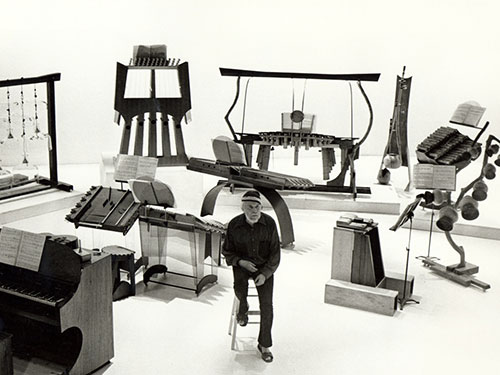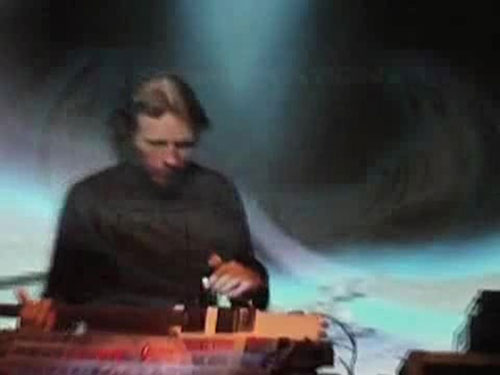Searching For The Perfect Tones
Guitars, bass, piano, and drums aren't the only way to make a tune. Check out the story of these unusual musical instruments—and the folks who played them.

The 43 tones of Harry Partch
If you’re into the avant garde, you know that there are plenty of musicians who like to challenge the way we think about music. John Cage famously turned four and a half minutes of silence into his most famous composition. The once-mainstream musician Scott Walker (who has a similar problem to Paul Rand), has punched a huge slab of meat as a source of percussion for one of his songs. And John Zorn, perhaps the greatest experimental musician of the 1980s, once recorded a 20-minute composition using wind machines as the main instrument—and he wasn’t even the first person to come up with that idea.
But perhaps the musician who was willing to stretch the furthest in the name of his muse was Harry Partch, a man who essentially invented his own alternative to the traditional musical scale system—a 43-tone behemoth that required him to invent his own instruments to even play along.
“I am a philosophic music man who was long ago seduced into musical carpentry,” Partch explained of his musical thought process in a two-part documentary (first part, second part) on YouTube.
Partch, over the years, adapted traditional Western instruments to his style of playing, as well as inventing his own unique instruments along the way. Perhaps his best-known instruments, the Chromelodeon I and II, were incredibly unusual takes on the pipe organ. (Here’s a sound clip of him playing the Chromelodeon I and explaining why he made it.)
His work over the decades eventually culminated in the creation of The World of Harry Partch, a record released by Columbia Records in 1969 which may rank among the most outré major label records ever produced. (He died a few years later, in 1974.) But it’s an important document of a man who followed his muse in ways few artists could say that that would today.
By the way, this isn’t just all a history lesson. In case you feel like playing some of his instruments yourself, you’re in luck: Back in 2004, American Public Media created an interactive feature that allows you to play many of his instruments note-for-note. (It requires Flash, however—sorry mobile users.)
“I had a lot of offers from people who said that they would help me but that I had to dress conventionally. but I valued my freedom of dress more than I cared to advance my career as a composer. I just wanted to do my own thing, and no matter how much it cost me in terms of my career, I did it.”
— Louis “Moondog” Hardin, discussing his unusual life as a street musician on the who could be regularly found in Midtown Manhattan. Moondog, a blind, bearded man who played unusual self-taught music near jazz clubs during the peak of the Beat poetry era, was known for dressing as a viking—a decision he made to avoid unfortunate comparisons to Jesus—and for inspiring musicians who ultimately brought him to prominence, like Steve Reich, Charlie Parker, and even Janis Joplin. Like Harry Partch, he invented a number of instruments, including the Trimba, the Oo, and the Hüs. (Also like Partch, he had a chance to record for Columbia Records in the late 1960s.) Here’s a video of Stefan Lakatos, a friend of the late musician, performing on the Trimba.
Five unusual instruments played by famous performers
- Leonard Cohen is one of the few mainstream musicians who embraced the Jew’s Harp, an instrument that’s placed in the mouth and plucked to make a vibrating noise. He makes reference to the instrument on his third album, and features it prominently on his second. He never got to performing “Crazy Train” on it, however.
- The Presidents of the United States of America managed to get a long way with just five strings. The band utilizes a very minimalist musical palette, including the guitbass, a three-string guitar, and the basitar, a two-string guitar with heavy bass strings. The band got their idea from another musician who liked playing heavily modified instruments, the late Mark Sandman of Morphine.
- When Sonic Youth had their musical equipment stolen in 1999, it was a much bigger deal for that particular band than it was for most. The reason? The band was famous for tearing apart the innards of their guitars, modifying their instruments to the point of unrecognizability, to get a very specific sound. So when they lost those instruments, they could no longer play some of their songs live anymore. (A few later showed up on the black market.)
- Another ’90s band, Cake, prominently featured the melodica in their first big hit, “The Distance.“ The melodica, which has been used by a wide variety of performers, is essentially a kazoo with a built-in keyboard. You blow into the instrument and press a set of keys, and it modifies the sound.
- Radiohead’s Jonny Greenwood has gotten a lot of mileage out of the Ondes Martenot, an early electronic music instrument that is akin to a theremin combined with a traditional keyboard. (The reason it makes such spooky noises can be credited to its vacuum tubes.) Greenwood has used the instrument on every one of the band’s albums since Kid A, and notably used it to create the brooding feel of the score to the 2007 film There Will Be Blood.

The guy I know who invented a 40-string instrument
Eleven years ago, I moved to the city of Milwaukee, where I didn’t really know anyone and had a lot of free time on my hands. Since there were only so many coffee shops I could visit in a day, I started playing open mics with my trusty ’ol Washburn acoustic guitar.
I probably wasn’t any good. But I kept at it, playing dozens of times at numerous venues through the city’s Riverwest and East Side neighborhoods. My fingers were fully calloused and my voice raspy, but I never made my breakthrough into becoming the next Elliott Smith that I dreamed of becoming. Probably for the best.
The reason I bring this up is because I met a really interesting dude who was working as the bartender at one of these open mics. His name is Jim Bartz, and he has a really fascinating hobby: He’s been chasing his dream of building a 40-string instrument for close to two decades.
The device, which he calls the Stringstation, works like this: the instrument combines a traditional six-string electric guitar with elements of other stringed instruments such as a chapman stick and lap steel guitars. Bartz’s concept instrument, which I’ve seen him play live a few times, is a pretty fascinating device that manages to cull out a wide array of noises from a stringed instrument hooked up to an odd array of electronics.
It’s actually an extension of something he’s been reaching for throughout his career—the idea of culling as much atmosphere out of his music as possible. In 1987, he created an album called Pictures of Earth and Space that notably emphasized that Bartz didn’t use any synthesizers to create the atmospherics that envelop the album.
The Stringstation is very much in that vein—as you can see from this live performance he did in 2011, he pulls a lot of life out of a bunch of strings. The playing strategies he uses combine elements of different types of guitar-playing, like finger-tapping, along with styles that would be more traditionally associated with a harp or similar large stringed instrument.
“I want to make an epic music statement that is sublime and beautifully seductive in ways we didn’t know sonics could be,” Bartz told the website It’s Psychedelic, Baby! in 2013—adding that he considers the creation of music with the completed instrument his “life long mission.”
I eventually lost touch with Jim—he moved to one city, and I moved to another at roughly the same time—but he’s still been working away at the instrument, which at this point only exists in prototype form. His instrument, and his passion for it, is a hard thing to forget, however.
Like the sustain on some of the strings he plucks, that passion sticks with you for a good long time.
In 1963, a truly groundbreaking tune became one of the most well-known television theme songs of all time, and the process for creating the tune was downright painstaking. Composer Ron Grainer may have come up with the basic tune for Doctor Who, but it was Delia Derbyshire—an expert composer of “musique concrète,” or found sounds modified with a reel-to-reel tape recorder—who turned the song into something magical.
Years before Robert Moog’s synthesizer gave electronic music a more traditional shape, the BBC had an entire department dedicated to talented sound effects composers like Derbyshire, who could create fascinating noises out of an unusual palette of tools. (This video offers some great perspective on what the BBC was doing at the time.)
Orbital’s Paul Hartnoll, a huge fan of Derbyshire’s work, suggested that the complications of composing in this way actually made the work more appealing to her.
“I think she got a bit disheartened and a bit bored with it all when the synthesizer came along and it all became a little too easy,” Hartnoll said in 2008.
Our devices allow us to do more than ever, but do they take the challenge out of it all? As you read this on your iPhone or laptop, let that one sit with you a while. It might strike a chord.
:format(jpeg)/2018/11/vk4u8b07u9j2z2cb51fh--1-.gif)
/2018/11/vk4u8b07u9j2z2cb51fh--1-.gif)

/uploads/ernie_crop.jpg)